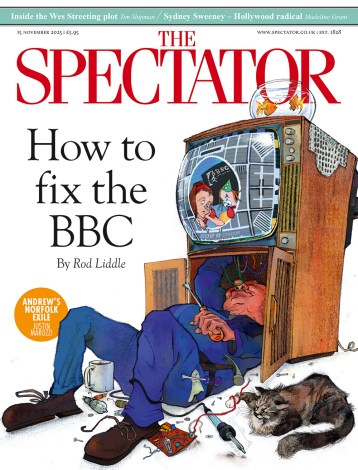Scottish Labour may be down but they’re not out. The polls have not been moving in their favour over the last few months and on the eve of Labour’s conference in Liverpool a Norstat survey for the Sunday Times brought more bad news: never mind losing out on first place at the 2026 Holyrood election, Scottish Labour could crash into third next year thanks to a surge in support for Nigel Farage’s leaderless tartan outfit. It would be a pretty humiliating state of affairs.
Yet despite all this, the mood in Scottish Labour is oddly buoyant, even upbeat. At the conference’s Scots Night, the Prime Minister made a quick cameo – bouncing into the soulless basement room to inform attendees that, no doubt about it, Anas Sarwar was going to be Scotland’s next first minister. Cue the applause from party loyalists and a few raised eyebrows from the journalists in the room, but despite the disparity between Sir Keir’s statement and the state of the polls, there was nothing forced about the optimism from Scottish Labour.
Why, just eight months out from the Scottish election after around eight months of poor polling, is the party so positive? A lot of the fervour comes from the belief that, ultimately, the surveys do not reflect how the country will vote next May. There is a widely-held view that recent data showing Farage’s group is within touching distance of becoming the official opposition next year are an indication more of voter frustration with Scotland’s established parties than a vote of confidence in Reform UK. On speaking to Scottish voters, this idea holds up: those who swung behind the right-wing crowd at the recent Hamilton by-election tended to agree that the Tories, Labour and the SNP had all had their chance and failed – so what else was left to try other than Reform? ‘But I wouldn’t want Farage as Prime Minister,’ one such Larkhall resident insisted.
So it’s likely the polls will narrow, but what if this simply serves to benefit the SNP? With the exception of a Survation poll in May last year, the current party of government has maintained a lead over Labour – although the nationalists are expected to lose a few seats from their current total of 60 and therefore not win a majority. While the unionist parties have the most to lose from Reform, it’s thought that the insurgent group could chip into the SNP vote as much as 10 per cent. But if this is reversed nearer the time – better the devil you know – it could tip the Nats into majority government territory. And if Starmer’s Westminster government continues the way it has been over the last year, the SNP could pick up former Labour supporters too.
Scottish Labour cites the strength of its ground campaign here. The party uses an app called Labour Doorstep when canvassing, which centralises the information gathered from the doors – namely voting intention – in one place. Party activists and local politicians have been hitting the streets for months, ensuring their operation is thorough, instructive and feeding back any problems raised: ‘We’re quite agile when responding to issues at a hyper-local level,’ one Scottish Labour canvasser remarked. This is in contrast to the SNP, which doesn’t have an app – ‘much like with NHS Scotland,’ a Labour insider quipped – relying instead on collecting voting intention, independence stance and Brexit position by activists filling out paper slips. ‘It’s a bit archaic,’ complained one SNP figure.
Labour also cite the recent Hamilton by-election as a success story that can be replicated across Scotland. Their candidate Davy Russell was local to the area and well-known across the constituency. He was almost immediately dismissed by both the commentariat and his opponents after it emerged he would not be taking part in an STV debate ahead of the poll. Attacks on Russell were ‘based on class and snobbery’, Glasgow East MP John Grady fumed after Labour’s victory – though one party adviser confessed that, despite their win, the local-above-all-else strategy was not something that they planned to copy across the rest of the country. Instead Scottish Labour is selecting candidates like teachers and doctors, success stories with experience of public sector work, to take the party into the next election. Not that Russell has had a bad time of it since getting into Holyrood: he’s proven himself an effective cross-party communicator who has struck up a friendship with SNP veteran-turned-independent MSP Fergus Ewing. And about those who doubted him, he chooses just to laugh: ‘The bookies were paying out for months after I won!’
Labour also cite the recent Hamilton by-election as a success story that can be replicated across Scotland.
The party has a tightly-knit leadership, with Anas Sarwar a personable, energetic leader with his extremely competent – and sharp – deputy Jackie Baillie at the helm. There is a vitality among the top team of politicians and advisers that the SNP will struggle to emulate after almost two decades in power – despite ‘fresh’ apparently being the nationalists’ campaign word of choice. But where Scottish Labour does fall short on a personnel level is in two key areas: firstly, in conveying this energy on camera across Scotland. Sarwar may be one of the most genuine politicians of his time – giving off that Barack Obama-like ‘people’s politician’ air – but it’s getting this across on broadcast and social media (where Reform does well) that has proven a challenge. Secondly: given many of Scottish Labour’s sitting MSPs are broadly unknown, the party faces an uphill battle raising the profile of its new candidates.
And then there is the issue of splits: new Scotland Secretary Douglas Alexander is capable and clearly ambitious, but his fellow MPs are still fairly rattled about the defenestration of Ian Murray. Murray – who had been in the role for 14 months, before that holding the title of shadow Scotland Secretary for five years – admitted he had felt ‘publicly humiliated’ when Starmer told him he was going to the backbenches. After a widespread backlash, the Prime Minister realised he’d misjudged this particular call. Less than a day later, Murray was made a minister in both the culture and science departments.
It took more than three days for any Scottish Labour MP to publicly welcome Alexander to the position, and there remained a degree of tension at the Liverpool conference. He may have been all smiles, but Alexander still seemed a little on edge at the Scots Night event – admitting later he was still adjusting to the job. Perhaps his academic insight will redeem him ahead of an election year: Alexander has worked at Harvard, Chicago University and even at a New York University outpost in Abu Dhabi. As Kenny Farquharson wrote in the Times, much of that work concentrated on the issue of populism – knowledge that may be leant on now, given Reform’s Scottish rise.
A bigger split may be on the horizon: senior Scottish Labour figures believe that a more definitive break from Starmer’s UK party is required if Sarwar is to convince voters his party is best for Scotland – although there is extreme scepticism about this among Scottish Labour MPs. Currently the group occupies a muddled middle ground where it is not as distant as Welsh Labour from the Westminster party and generally tries to remain loyal – but subjects like welfare have tested this relationship.
Rachel Reeves is expected to scrap the two-child benefit cap for a tapered system at her upcoming Budget, a move for which Scottish Labour will claim credit. The party insist they have been prepared time and time again to stand up to Westminster, but doing so in a way that avoids ‘huge rifts!’ headlines has meant that principled stands haven’t really cut through to voters. And there remains the rather confusing issue, as always, of devolution. Scottish voters are now blaming Starmer for the state of Scotland’s NHS, despite healthcare being devolved. All this leaves a lot of explaining to do on the doorsteps, and with less than eight months until the Scottish election, time is running out.








Comments